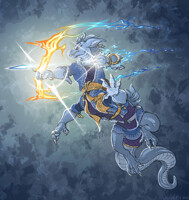
A Primer on Alurian Space Travel (Part 1)
(Art from February, 2017)
A Primer on Alurian Space Travel
<<< PREV | FIRST | NEXT >>>
Pictured, Left:
The Traveler, an early Alurian starship, created to safely carry astronauts to other destinations in the Ryndu star system, and with minimal need for re-supplies. The first generations were cramped, slow, and required frequent maintenance, but did the job nonetheless. From those earliest models came the inspiration for the next generation of Travelers... Their design would be very much the same, but they would also prove vastly more reliable. The few travelers in use today were originally built hundreds of years ago, receiving upgrades and replacements over that span of time.
Pictured, Bottom Right:
Similarly, the Navigators, vehicles designed to transport explorers across otherworldly terrain, have seen little in the way of change. Its rugged construction has lent itself to long term use, with only minor upgrades needed to keep it relevant for modern applications.
Pictured, Top Right:
Luckily for the Alurians wearing them, space suits have improved by leaps and bounds compared to their earliest prototypes. Pictured is a version from approximately 70 years ago, the first generation to bear nearly all the same features as current technology... But modern suits have the luxury of a much more sleek and stylish aesthetic. Astronauts in the newest gear can achieve their full range of vision and motion, and are much more nimble than early explorers.
Once upon a time,
Our ancestors were slaves to gravity. Any obstacles they faced in their travels had to be conquered on foot, and they spent their entire lives firmly affixed to the ground. Vast canyons, steep mountains, dense forests, raging oceans… All these and more stood in the way of the early Alurians, limiting how much of our world they were able to safely navigate.
We imagine that in those days, they looked upward to the creatures that, seemingly impossibly, levitated in the air.
“How unfair!” they must have declared, “That we were not built to harness the wind, to sail across ravines without fear of falling, to float above the trees, rather than being tangled within them!”
As ground-dwellers, those Alurians knew directions like Forward and Backward, Left and Right. Up and Down existed, they understood, but only in limited capacity. An Alurian could go Up, but only in the places that the world allowed for it, such as by climbing a tall tree. But these creatures, the birds, the gliders, and the sail-winged Trilerachast… They could navigate Up and Down freely.
A great many generations would pass before our ancestors learned enough to be able to build tools that could help them traverse the skies on their own terms. With that, they could cross large distances faster than ever before, and the whole world opened to them. The direction called Up is a useful one, indeed.
Of course, that was not the end of our journey. We went further and further upward, spurred on by our boundless desire to explore, but it wasn’t long before we hit another snag: Space is exponentially, unfathomably larger than our planet. Even the scale of our own solar system presented a challenge. Going any further beyond it, despite our best efforts, appeared to be out of the question.
We would need a new direction...
All Trinity Project species and settings are OPEN! If you wish to create something within the TP universe, please read this Journal first.
All copyright-able Trinity Project content is licensed under a Creative Commons Attribution-NonCommercial-ShareAlike 4.0 International License.
Thank you, and I hope you enjoy!
A Primer on Alurian Space Travel
<<< PREV | FIRST | NEXT >>>
Pictured, Left:
The Traveler, an early Alurian starship, created to safely carry astronauts to other destinations in the Ryndu star system, and with minimal need for re-supplies. The first generations were cramped, slow, and required frequent maintenance, but did the job nonetheless. From those earliest models came the inspiration for the next generation of Travelers... Their design would be very much the same, but they would also prove vastly more reliable. The few travelers in use today were originally built hundreds of years ago, receiving upgrades and replacements over that span of time.
Pictured, Bottom Right:
Similarly, the Navigators, vehicles designed to transport explorers across otherworldly terrain, have seen little in the way of change. Its rugged construction has lent itself to long term use, with only minor upgrades needed to keep it relevant for modern applications.
Pictured, Top Right:
Luckily for the Alurians wearing them, space suits have improved by leaps and bounds compared to their earliest prototypes. Pictured is a version from approximately 70 years ago, the first generation to bear nearly all the same features as current technology... But modern suits have the luxury of a much more sleek and stylish aesthetic. Astronauts in the newest gear can achieve their full range of vision and motion, and are much more nimble than early explorers.
Once upon a time,
Our ancestors were slaves to gravity. Any obstacles they faced in their travels had to be conquered on foot, and they spent their entire lives firmly affixed to the ground. Vast canyons, steep mountains, dense forests, raging oceans… All these and more stood in the way of the early Alurians, limiting how much of our world they were able to safely navigate.
We imagine that in those days, they looked upward to the creatures that, seemingly impossibly, levitated in the air.
“How unfair!” they must have declared, “That we were not built to harness the wind, to sail across ravines without fear of falling, to float above the trees, rather than being tangled within them!”
As ground-dwellers, those Alurians knew directions like Forward and Backward, Left and Right. Up and Down existed, they understood, but only in limited capacity. An Alurian could go Up, but only in the places that the world allowed for it, such as by climbing a tall tree. But these creatures, the birds, the gliders, and the sail-winged Trilerachast… They could navigate Up and Down freely.
A great many generations would pass before our ancestors learned enough to be able to build tools that could help them traverse the skies on their own terms. With that, they could cross large distances faster than ever before, and the whole world opened to them. The direction called Up is a useful one, indeed.
Of course, that was not the end of our journey. We went further and further upward, spurred on by our boundless desire to explore, but it wasn’t long before we hit another snag: Space is exponentially, unfathomably larger than our planet. Even the scale of our own solar system presented a challenge. Going any further beyond it, despite our best efforts, appeared to be out of the question.
We would need a new direction...
All Trinity Project species and settings are OPEN! If you wish to create something within the TP universe, please read this Journal first.
All copyright-able Trinity Project content is licensed under a Creative Commons Attribution-NonCommercial-ShareAlike 4.0 International License.
Thank you, and I hope you enjoy!
Category Artwork (Digital) / General Furry Art
Species Unspecified / Any
Size 1144 x 1000px
File Size 351.9 kB
Listed in Folders
This reminds me of something completely tangential but I'll share: All of mankind's technological development/history can be summarized as us getting better at fire, at least up until the modern age.
Cooking food? Fire. Smithing? Using fire to turn metal into things. Iron age? Making fires hot enough to do more advanced smithing. Combustion engine? Channeling fire to move things. Space exploration? Getting enough fuel to light on fire to propel yourself into space!
Cooking food? Fire. Smithing? Using fire to turn metal into things. Iron age? Making fires hot enough to do more advanced smithing. Combustion engine? Channeling fire to move things. Space exploration? Getting enough fuel to light on fire to propel yourself into space!
Really an interesting design for a space-ship. Were you by chance inspired by the suggested starship for project daedalus?
https://en.wikipedia.org/wiki/Project_Daedalus
Truly love how you draw these kind of vehicles.
https://en.wikipedia.org/wiki/Project_Daedalus
Truly love how you draw these kind of vehicles.
What an interesting similarity! To be honest, I hadn't seen that concept before.
I was just going for something that could be designed by a species that's a bit ahead of us technologically. This thing predates "space magic" by some time, so it's still pretty utilitarian, much like what humans might dream up on a day where we're feeling particularly ambitious. I'll take the Daedalus concept as a sign that I've succeeded. :P
Thanks for the link, it was a neat read!
I was just going for something that could be designed by a species that's a bit ahead of us technologically. This thing predates "space magic" by some time, so it's still pretty utilitarian, much like what humans might dream up on a day where we're feeling particularly ambitious. I'll take the Daedalus concept as a sign that I've succeeded. :P
Thanks for the link, it was a neat read!
Hehehe, you are all welcome.
Really surprised to hear that you created a very similar design by sheer coincidence. And I guess that in your lore at least they did not ever consider the orion-puls-engine. That was a suggestion for an even older project than the Daedalus concept, where interstellar probes were propulsed by nukes detonating at the rear of the space-ship.
Really surprised to hear that you created a very similar design by sheer coincidence. And I guess that in your lore at least they did not ever consider the orion-puls-engine. That was a suggestion for an even older project than the Daedalus concept, where interstellar probes were propulsed by nukes detonating at the rear of the space-ship.

 FA+
FA+










Comments